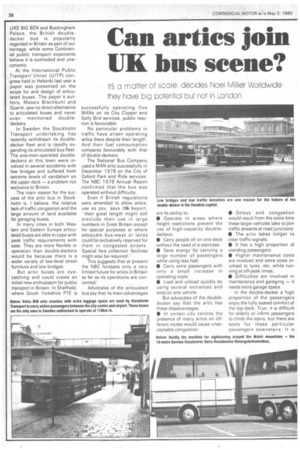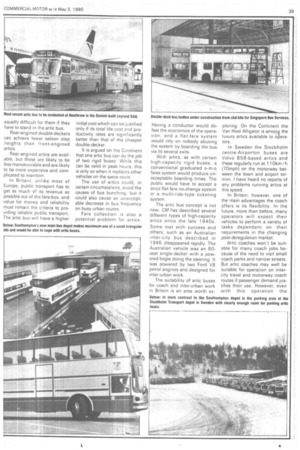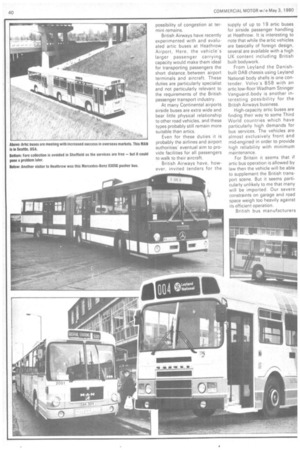Can artics join UK bus scene?
Page 40

Page 41

Page 42

Page 43

If you've noticed an error in this article please click here to report it so we can fix it.
It's a matter of scale. decides Noel Millier Worldwide they have big potential but not in London
LIKE BIG BEN and Buckingham Palace, the British doubledecker bus is popularly regarded in Britain as part of our heritage, while some Continental public transport exponents believe it is outmoded and uneconomic.
At the International Public Transport Union (UITP) congress held in Helsinki last year a paper was presented on the scope for and design of articulated buses. The paper's authors, Messrs Brechbuhl and Quaff& saw no direct alternative to articulated buses and never even mentioned doubledeckers.
In Sweden the Stockholm Transport undertaking has recently withdrawn its doubledecker fleet and is rapidly expanding its articulated bus fleet. The one-man-operated doubledeckers at this town were involved in several accidents with low bridges and suffered from extreme levels of vandalism on the upper deck — a problem not exclusive to Britain.
The main reason for the success of the artic bus in Stockholm is, I believe, the relative lack of traffic congestion and the large amount of land available for garaging buses.
In many cities in both Western and Eastern Europe articulated buses are able to cope with peak traffic requirements with ease. They are more flexible in operation than double-deckers would be because there is a wider variety of low-level street furniture and low bridges.
But artic buses are eyecatching and could create an initial new enthusiasm for public transport in Britain. In Sheffield, where South Yorkshire PTE is successfully operating five MANs on its City Clipper and Early Bird services, public reaction is favourable.
No particular problems in traffic have arisen operating artics there despite their length. And their fuel comsumption compares favourably with that of double-deckers.
The National Bus Company used a MAN artic successfully in December '1978 on the City of Oxford Park and Ride services, The NBC 1978 Annual Report confirmed that the bus was operated without difficulty.
Even if British regulations were amended to allow artics. use as psv, says it* ireport, -their great length might still preclude their use in large numbers in Great Britain except for special purposes or where adequate bus-ways or lanes could be exclusively reserved for them in congested streets. Special fare collection facilities might also be required."
This suggests that at present the NBC foresees only a very limited future for artics in Britain as far as its operations are concerned.'
Advocates of the articulated bus say that its main advantages are its-ability to; • Operate in areas where height restrictions prevent the use of high-capacity doubledeckers; • Carry people all on one deck without the need of a staircase; • Save energy by carrying a large number of passengers while using less fuel; • Carry extra passengers with only a Small increase in operating costs;
• Load and unload quickly by usingseveral entrances and exits on one vehicle.
But advocates of the doubledecker say that the artic has these disadvantages: • In certain city centres the presence of many artics on different routes would cause unacceptable congestion; • Delays and congestion would result from the extra time these larger vehicles take to join traffic streams at road junctions; • The artic takes longer to clear traffic signals; • It has a high proportion of standing passengers; • Higher maintenance costs are involved and extra costs involved to tyres, etc, while running at off-peak times;
• Difficulties are involved in maintenance and garaging.— it needs extra garage space.
In the double-decker a high proportion of the passengers enjoy the fully seated comfort of the top deck. True, it is difficult for elderly or infirm passengers to climb the stairs, but there are seats for these particular passengers downstairs. It is equally difficult for them if they have to stand in the artic bus.
Rear-engined double-deckers can achieve lower saloon step heights than front-engined artics.
Rear-engined artics are available, but these are likely to be less manoeuvrable and are likely to be more expensive and complicated to maintain.
In Britain, unlike most of Europe, public transport has to get as much of its revenue as possible out of the fare-box, and value for money and reliability must remain the criteria to providing reliable public transport. The artic bus will have a higher initial cost which can be justified only if its total life cost and productivity rates are significantly better than that of the cheaper double-decker.
It is argued on the Continent that one artic bus can do the job of two rigid buses. While this can be valid in peak hours, this is only so when it replaces other vehicles on the same route.
The use of artics could, in certain circumstances, avoid the causes of bus bunching, but it could also cause an unacceptable decrease in bus frequency on busy urban routes.
Fare collection is also a potential problem for artics. Having a conductor would defeat the economics of the operation, and a flat-fare system would rely on nobody abusing the system by boarding the bus via its several exits.
With artics, as with certain high-capacity rigid buses, a conventional graduated o-m-o fares system would produce unacceptable boarding times. The public would have to accept a strict flat-fare no-change system or a multi-ride-type ticketing system.
The artic bus concept is not new; CM has described several different types of high-capacity artics since the late 1940s. Some met with success and .others, such as an Australian inter-city bus described in 1946, disappeared rapidly. The Australian vehicle was an 80seat single-decker with a powered bogie doing the steering. It was powered by two Ford V8 petrol engines and designed for inter-urban work.
The suitability of artic buses for coach and inter-urban work in Britain is an area worth ex
ploring. On the Continent the Van Hool Alligator is among the luxury artics available to okrators.
In Sweden the Stockholm centre-Airporton buses are Volvo B58-based artics and these regularly run at 110km /h (70mph) on the motorway between the town and airport termini. I have heard no reports of any problems running artics at this speed.
In Britain, however, one of the main advantages the coach offers is its flexibility. In the future, more than before, ,many operators will expect their vehicles to perform a variety of tasks, dependent on their requirements in the changing post-deregulation market.
Artic coaches won't be suitable for many coach jobs because of the need to visit small coach parks and narrow streets. But artic coaches may well be suitable for operation on intercity travel and motorway coach routes if passenger demand justifies their use. However, even with this operation the possibility of congestion at termini remains.
British Airways have recently experimented with and evaluated artic buses at Heathrow Airport, Here, the vehicle's larger passenger carrying capacity would make them ideal for transporting passengers the short distance between airport terminals and aircraft. These duties are particularly specialist and not particularly relevant to the requirements of the British passenger transport industry.
At many Continental airports airside buses are extra wide and bear little physical relationship to other road vehicles, and these types probably still remain more suitable than artics.
Even for these duties it is probably the airlines and airport authorities' eventual aim to provide facilities for all passengers to walk to their aircraft.
British Airways have, however, invited tenders for the supply of up to 1 9 artic buses for airside passenger handling at Heathrow. It is interesting to note that while the artic vehicles are basically of foreign design, several are available with a high UK content including British built bodywork.
From Leyland the Danishbuilt DAB chassis using Leyland National body shells is one contender. Volvo's B58 with an artic low-floor Wadham Stringer Vanguard,body is another interesting possibility for the British Airways business.
High-capacity artic buses are finding their way to some Third World countries which have particularly high demands for bus services. The vehicles are almost exclusively front and mid-engined in order to provide high reliability with minimum maintenance.
For Britain it seems that if artic bus operation is allowed by law then the vehicle will be able to supplement the British transport scene. But it seems particularly unlikely to me that many will be imported. Our severe constraints on garage and road space weigh too heavily against its efficient operation.
British bus manufacturers should, however, be in a position to manufacture artic buses as the worldwide demand for this type of vehicle is evident. And areas do exist in Britain where passenger densities could justify and road conditions could tolerate artic bus operation.
The initial experience of South Yorkshire suggests that the mid-engined MANs and Leyland DAB use less fuel than the average rear-engined decker. It seems probable that the pusher buses will use more fuel. With fuel very much in the -public eye, this is a big plus point in favour of artics.
The case for artics in Britain does have strong points. But many of these points could also be used in order to favour larger capacity, longer doubledeckers.
Artics are more likely to prove effective only in a modern well laid out city — with land available for garage and maintenance facilities. Here, the artic bus could be the most economic answer to public transport.
While more passengers could be accommodated more comfortably in the same road space by using 10-metre double-deck
buses than if artics were used, more actual vehicles and drivers would have to be employed to carry these extra passengers. However, if 12-metre doubledeckers were used the road space could accommodate still more passengers. Fewer 12metre vehicles would be needed, though not as few buses as if artics were employed.
In 1,800 metres of road space: 100 artic buses could accommodate 12,000 passengers; 180 10-metre double-deckers could accommodate 14,400 passengers; 150 12-metre double-deckers could accommodate 16,500 passengers.
All the passengers on the double-deck buses could be seated, but only half the passengers on the artic buses enjoy seats.
In areas where efficient use of available road space is a major consideration, such as London, Singapore and Hong Kong, the double-decker bus runs out a clear winner.
In terms of energy and staff efficiency the artic bus leads although the 12-metre decker is only just behind it. However, since most bus services in Britain have spare capacity outside peak hours, the overall economics warrant further careful consideration.
The artic bus could save valuable seconds at bus stops by allowing passengers easier access through its many exits (assuming an adequate-fare collection system), but the doubledecker could save this time by joiningthe traffic queues and streams more quickly. The double-decker can also provide more peak-hour comfort by accommodating a greater number of seated passengers.
Both types of bus have advantages and disadvantages for the aged and infirm. With the double-decker the main disadvantage is the stairs. But artics need a large amount of standing-only capacity in order to achieve high overall capacity. Both artic buses and doubledeckers have their places in modern transport systems for most areas in the world. The correct economic choice must depend on a large number of factors, including available road space, garage space and passenger loadings.
In the UK generally these points favour the use of our traditional British doubledecker. There is, though, nothing sinister about the artic bus, and a skilled psv driver should have no problem handling one in normal conditions.
Problems could exist in certain emergency and unusual circumstances owing to the need for extra road space to be available when reversing. This consideration makes the need for adequate enforcement of parking regulations crucial when artics are being run.












































































































